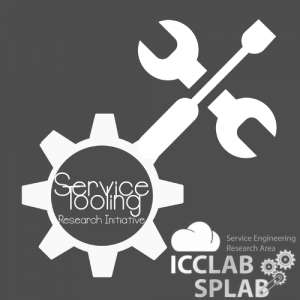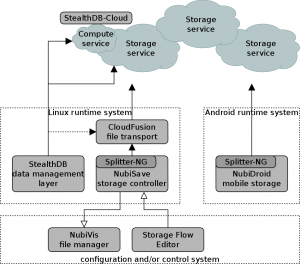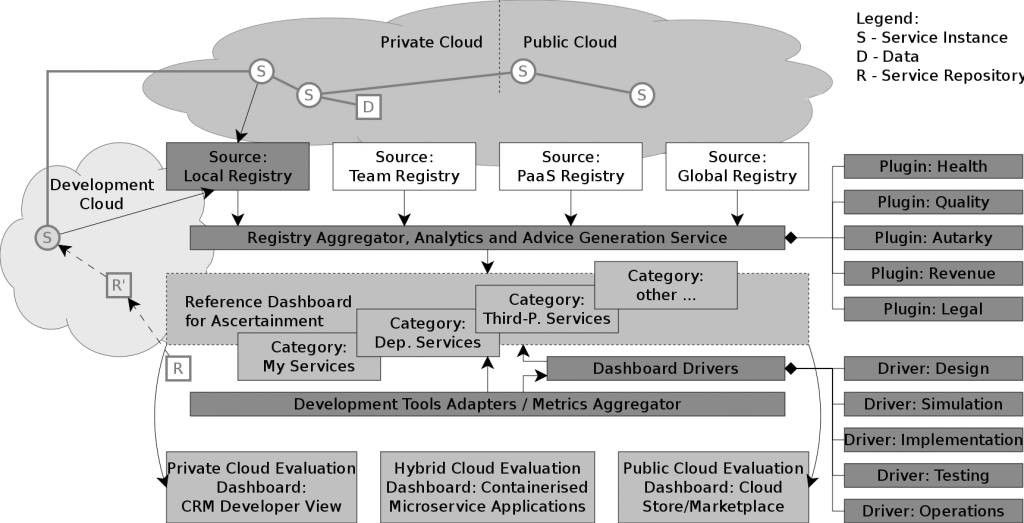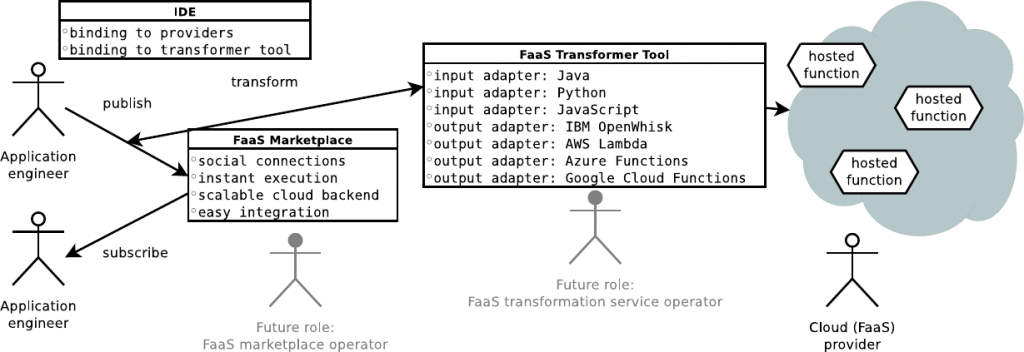 Overview
Overview
Working with remote services requires appropriate and decent tooling. A service idea may take just five seconds (“I want to offer a robust note-taking service”), but its realisation may take much longer (“Which programming language and model?”, “How to describe the service?”, “Where do I find a fitting file service to store the notes on unless I want to take care of backups by myself?”, “Where do I publish my service so that it runs and generates income?”). Therefore, modelling, engineering and integration tools are primarily needed. These tools work in combination with a certain service environment, or ecosystem, consisting of more tools, dependency services, and service platforms which bring services to life.
Open source service platforms such as SPACE and FIWARE went from being architectural visions to actually usable platforms. However, in comparison to cloud stacks and commercial cloud services, their popularity is limited and they are far from being used pervasively. Therefore, the Service Tooling research initiative of the Service Prototyping Lab intends to identify tools and platform services which are straightforward to deploy, easy to use and generic enough to be re-usable in many service scenarios.
For this purpose, the initiative follows a triple structure with three topics of increasing industrial and societal interest: Function-as-a-Service (FaaS), Stealth Computing, Cloud Ecosystems.
Objectives
- Research and innovation in the entire service lifecycle through advanced tooling: Modelling, publishing, running, consuming and evolving services and service-based applications. This initiative will therefore contribute open source tools to build service platforms, ecosystems and individual applications.
- Layered architectures for services and clients, including adaptive invocation and stealth data management, to benefit from service and cloud environments while overcoming their limitations.
- In connection with CNA, identification of suitable tooling for engineering cloud-native applications, in particular aiming at extreme microservices (nanoservices) with FaaS.
- Adaptation of applications to execution technologies in general: VMs, containers, packages, functions, unikernels. None of these should be a concern to an application engineer and therefore automated tooling is required.
Stealth Computing Architecture
In this part of the initiative, there are a number of architectures depending on the use case and the lifecycle phase of a service. The following diagram represents a typical multi-cloud service integration point with stealth properties. Software applications and services benefit from spreading their data and functions across providers in a tightly controlled, re-usable layer with standard interfaces such as files (e.g. POSIX) and data (e.g. SQL). Users are more willing to adopt cloud environments when explicit user control is made possible by stealth computing.
 Cloud Ecosystems Architecture
Cloud Ecosystems Architecture
This part of the initiative explores marketplaces, brokers, dashboards, cloud migration tools, API generators, aggregators and other enablers of thriving ecosystems with service producers and consumers. The research focuses on prototyping techniques with description/implementation roundtripping, a library of utility services which aid in establishing ecosystems, and improved client-side tools such as CLI helpers.

Function-as-a-Service Architecture
In the FaaS part of the initiative, tools to bring legacy code into FaaS environments as well as tools to advance the environments themselves are investigated. There are software decomposition tools for Python (Lambada) and for Java (Podilizer, Termite). Furthermore, there is a flexible client/server tool to migrate, execute, test and deploy functions written in several languages (Snafu).

Articles and Publications
Note: Preprints are made available in a timely manner. Check preprints.
- J. Spillner, M. Beck, A. Schill, T. M. Bohnert: Stealth Databases: Ensuring User-Controlled Queries in Untrusted Cloud Environments, 8th IEEE/ACM International Conference on Utility and Cloud Computing (UCC), Limassol, Cyprus, December 2015. (PDF author version) (Slides)
- J. Spillner: Secure Distributed Data Stream Analytics in Stealth Applications. 3rd IEEE International Black Sea Conference on Communications and Networking (BlackSeaCom), Constanța, Romania, May 2015.
- J. Spillner, J. Müller: PICav: Precise, Iterative and Complement-based Cloud Storage Availability Calculation Scheme. 7th IEEE/ACM International Conference on Utility and Cloud Computing (UCC), London, UK, December 2014. (PDF)
- J. Spillner, A. Chaichenko, A. Brito, F. Brasileiro, A. Schill: Cloud Resource Recycling: An Addition of Species to the Zoo of Virtualised, Overlaid, Federated, Multiplexed and Nested Clouds. SDPS Transactions: Journal of Integrated Design and Process Science (JIDPS), vol. 18, no. 1, pp. 5-19, April 2014.
- J. Spillner, S. Illgen, A. Schill: Engineering Service Level Agreements: A Constrained-Domain and Transformation Approach. 3rd International Conference on Cloud Computing and Services Science (CLOSER), Aachen, Germany, May 2013.
Blog Posts
Note: Latest posts are on top.
- Transducing service descriptions into SaaS prototypes
- Introducing Podilizer: Automated Java code translator for AWS Lambda
- Rapid API generation with Ramses
- Programmatic identification of cloud providers
- FaaS: Function hosting services and their technical characteristics
- Walk-through: Importing virtual machine images into EC2
- Making Tools Robust and Breaking Robust Tools
Presentations
- Talk of J. Spillner: The Next Service Wave: Prototyping Cloud-Native and Stealthy Applications. IBM Research Zurich, September 2015. (Slides)
- Talk of J. Spillner: Safe File Storage and Databases. GÉANT3+ Datacenter IaaS Workshop, Helsinki, Finland, September 2014. (Slides)
- Talk of J. Spillner: Operating the Cloud from Inside Out. HPI Operating the Cloud Symposium, Potsdam, Germany, September 2013. (Video)
- Talk of J. Spillner: Flexible Service Ecosystems: The serviceplatform.org perspective. 8th KuVS NGSDP Expert Talk, Königswinter, Germany, April 2013. (Slides)
Open Source Software
Note: The software repositories are hosted in the Service Prototyping Lab Github account. Some of our smaller tools are operated live on a Labsite. Check labsite.
- Podilizer: Decompose legacy Java code into functions and deploy them into an AWS Lambda environment.
- Transducer: Service interface transducer for rapid prototyping. Creates a running service mockup from a RAML description.
- Lambda Control Plane applications: Lambackup & LaMa. Store and process data in the AWS Lambda control plane.
- Whatcloud: Identification of cloud provider by network location.
- AWS-CLI-Retry: AWS-CLI tools with retry patches. A wrapper around AWS-CLI for more robustness.
- now archived: Open Source Service Platform Research Initiative, with further links to the SPACE service platform, spotmarkets, crowdserving portal, π-box for user-controlled access to clouds, nested virtualisation etc.
- now archived: Cloud Storage Lab, with further links to dispersed storage and computing as well as stealth computing tools, such as NubiSave and StealthDB
Contact
Josef Spillner: josef.spillner(at)zhaw.ch